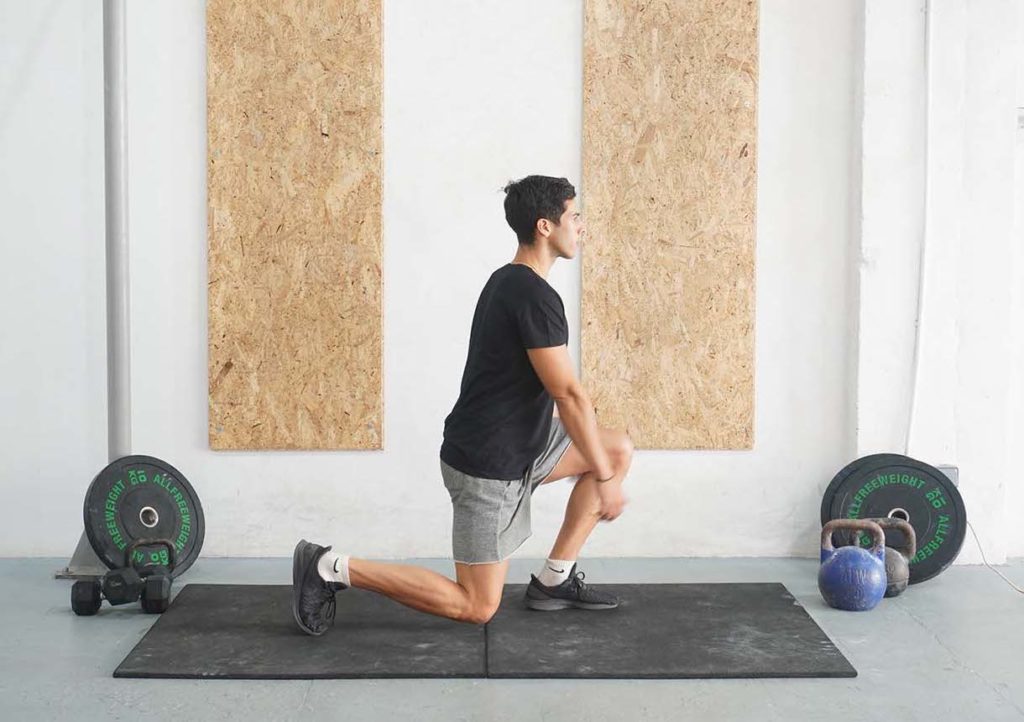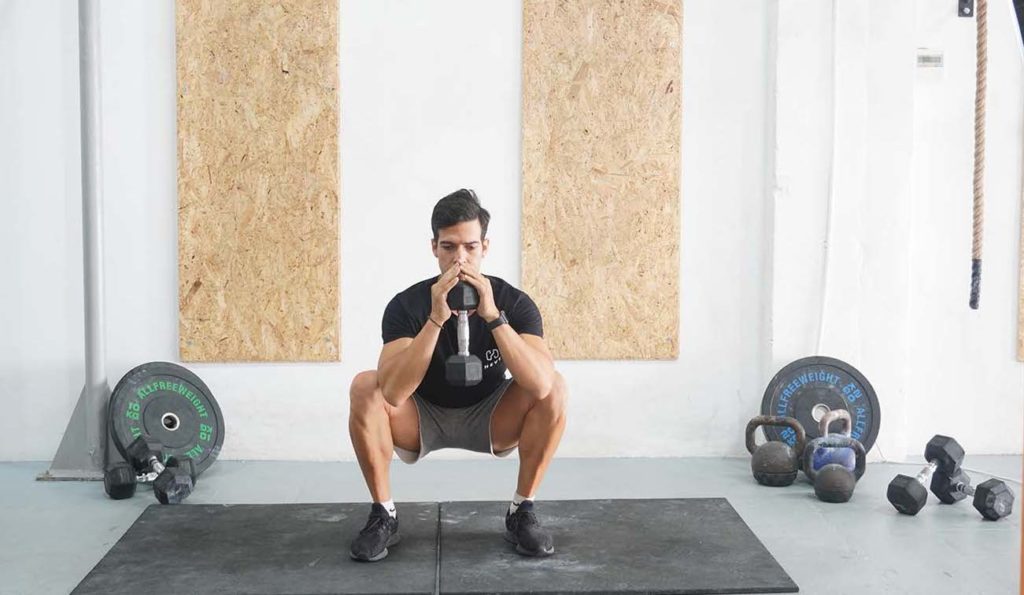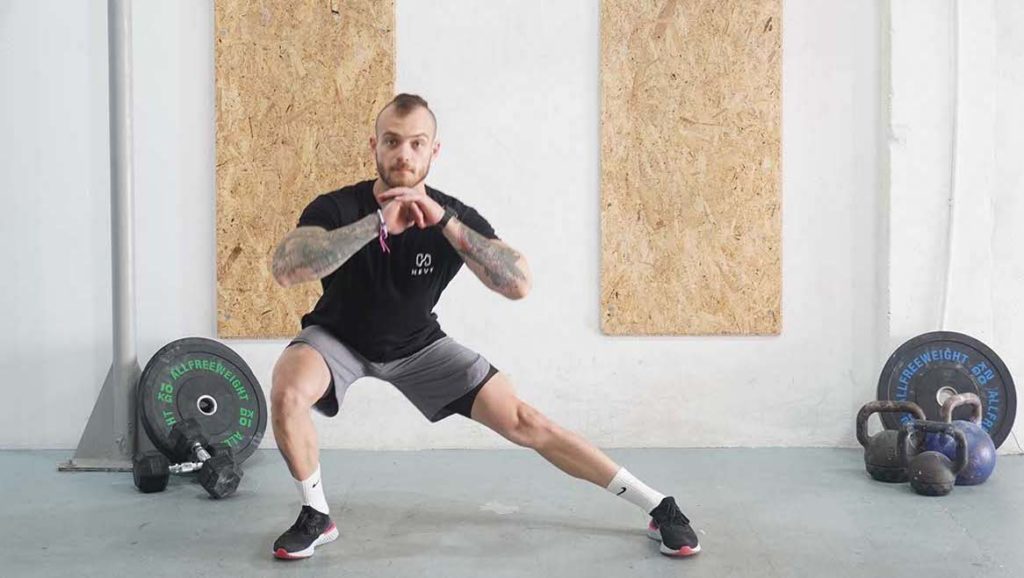Benefits of a Lunge with Dumbbells
Lunges are a simple and highly functional lower body exercise that strengthens a range of muscles and improves your balance. Unlike many leg exercises, the lunge is unique because you’re training one leg at a time. As such, the movement allows you to focus more of your attention and stimulate both legs effectively. The lunge is also beneficial for preventing side-to-side muscle or strength imbalances because each leg must work independently.
The lunge is a functional movement because it improves your fitness, allowing you to perform better at sports, and making everyday tasks easier to handle. For example, lunges strengthen all the muscles you use for climbing stairs, making the activity more accessible.
As an accessory lower body exercise, you can program lunges in many ways. For instance, you can include lunges as a third or fourth exercise in a leg workout. You can also experiment with the exercise’s many variations: alternating, walking, reverse, stationary, jumping lunges, and more.
How to do Dumbbell Lunge
- Grab a pair of moderately-heavy dumbbells and bring them to your sides.
- With your arms straight and palms facing your thighs, bring your shoulders back, direct your gaze forward, and take a breath. Have your feet close to one another with your toes pointed slightly out.
- Bring your right leg forward, plant your foot firmly, and descend into a lunge by bending the knee.
- Go down as comfortably as you can – ideally until your right thigh is almost parallel with the floor and your left knee taps the ground lightly.
- Hold the position for a moment and, as you exhale, push through your right foot to kick yourself back to the starting position.
- Take another breath and step forward with your left leg to repeat the whole thing.
- Keep alternating between your right and left leg until you finish the set.
What muscles does a dumbbell lunge activate?
The primary muscles involved in the lunge are the quadriceps (1). Our quadriceps cover the front side of our upper thighs, producing knee extension (2). As we lunge, our quadriceps control us on the way down, then contract to extend the knees and bring us back to the top. The rectus femoris, one of the quadricep heads, also crosses the hip, offering some midsection stability.
Unlike squats, lunges cause significantly higher gluteal activation (1). The gluteal muscle group consists of three muscles (gluteus maximus, minimus, and medius), two of which (maximus and medius) produce hip extension during lunges.
The lunge also activates our hamstrings to some degree (1). Our hamstrings cover the rear of our thighs, playing an essential role in knee flexion and hip extension (3). Our hamstrings cause hip extension during a lunge and stabilize the knee and hip.
Our midsection musculature (rectus abdominis, transverse abdominis, and obliques) also contributes during lunges, mainly to provide torso stability.
Proper Technique when Performing a Lunge
The first element of an effective lunge is to bring your front foot forward enough but not too much. The correct stance will be long enough for your front knee to be over your foot. Your shoulder, hip, and rear knee should be in a straight line. Looking at yourself in a mirror or filming some of your sets might help with proper alignment.
Proper breathing is also essential for a good lunge. Breathing well contributes to midsection rigidity and allows you to make the most of your lunge performance. Breathe in before you lunge and exhale as you go back up to the top position.
The third important tip to keep in mind for lunges is to brace effectively. Engage your midsection muscles before each set and maintain the muscle contraction until you’re finished. Doing so will provide adequate torso stability, allowing you to do the exercise safely.
You should also maintain an upright torso as you do the exercise. Bring your shoulders back and direct your gaze forward for lunges. Slouching makes the movement unnecessarily difficult because it prevents you from engaging your midsection muscles as effectively.
Variations and Modifications of the Dumbbell Lunge
1. Walking Lunge
Walking lunges are a more advanced exercise variation that combines forward motion with lunging. Instead of lunging back from the bottom, extend your knees and bring the rear leg to the front position. Doing so allows you to move forward with each repetition.
2. Reverse Lunge

Reverse lunges are a variation where you alternate between your left and right leg. But, instead of lunging forward, you bring the foot back behind your body. Doing so is beneficial because it puts less pressure on your front knee and requires slightly less stability. As such, the reverse lunge is a more beginner-friendly variation and suitable for folks with previous knee issues.
3. Stationary Lunge
The stationary lunge is a beginner-friendly variation that requires less stability. Instead of alternating between the left and right leg, you lunge forward, assume a position, and do all of your repetitions for one leg. Once finished, you bring your other leg forward and do the same number of reps.
Mistakes to Avoid
A common mistake is lunging too far forward, which offers no immediate benefits and only makes the movement more challenging. To avoid the mistake, begin with more conservative strides, focusing on even load distribution between the front and rear leg. Your front shin should be vertical, and your shoulders, hips, and the knee of the rear leg should be in line.
Another mistake with lunges is pushing from an unstable position. Many beginners struggle to remain balanced but continue to do shaky repetitions. Avoid the error by doing slow repetitions and lunging back to the starting position once you’re confident in your balance. If slow repetitions don’t help, do stationary lunges to build strength and balance in your lower body.
The third mistake to look out for when doing lunges is shortening the range of motion. Many trainees lunge forward but don’t go deep enough, robbing their quadriceps, hamstrings, and glutes of an adequate growth stimulus. Avoid the error by lowering yourself until your back knee taps the floor, even if it means not using external weights.
Similar Exercises to the Dumbbell Lunge
Goblet Squat

Like dumbbell lunges, goblet squats are an accessory exercise where you hold a dumbbell or kettlebell in front of your chest as you squat. Doing so forces you to maintain a more upright torso, leading to a more significant quad and upper back activation (4).
Lateral Squat

Lateral squats are an underrated accessory exercise that trains the often ignored adductors (inner thigh muscles). Like lunges, lateral squats emphasize one leg at a time, and the primary difference is that you have to step to the side and descend into a squat instead of moving forward or back.
